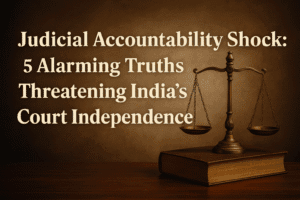Judicial Accountability Shock: 5 Alarming Truths Threatening India’s Court Independence
The Justice Varma case tests India’s constitutional balance between judicial independence and accountability. Our founding documents established peer review – not political intervention – as the legitimate path for judicial scrutiny. Removal requires Parliament’s impeachment, but only after a judicial committee investigation under the Judges (Inquiry) Act, 1968. This safeguards judges from political pressure while ensuring serious misconduct faces consequences.
Calls to bypass this process, like recent executive branch comments, risk undermining judicial autonomy essential for fair verdicts against powerful interests. While allegations demand rigorous examination, the Constitution mandates that fellow judges – not politicians – conduct initial inquiries. True accountability honors both the rule of law and its guardians: rushing to political solutions compromises the very justice system we seek to protect. The integrity of every future court ruling depends on upholding this delicate equilibrium.

Judicial Accountability Shock: 5 Alarming Truths Threatening India’s Court Independence
The recent controversy surrounding Justice Yashwant Varma – where significant cash was reportedly recovered from his official residence – has ignited more than just political debate. It has plunged India back into a fundamental constitutional question: How does a democracy hold its highest judges accountable without sacrificing the judicial independence essential to its function?
This isn’t merely a procedural squabble; it strikes at the heart of our constitutional balance. As legal scholar Arghya Sengupta highlighted, the tension between legislative supremacy (championed by Nehru) and an assertive judiciary (embodied by figures like Justice Sabharwal) is a defining feature of modern India. The Supreme Court, through landmark cases like Keshav Singh (1965) and PUCL (2005), firmly established the Constitution itself as supreme, replacing outdated notions of absolute parliamentary control.
The Constitutional Safeguard: Not a Shield for Misconduct
The framers of our Constitution wisely erected robust protections for judicial independence:
- Security of tenure (removable only via complex impeachment)
- Salaries charged to the Consolidated Fund (immune from political whims)
- Protection from legislative discussion on conduct (except during impeachment)
- Immunity under laws like the Judges (Protection) Act, 1985.
Critically, Articles 124 (for Supreme Court) and 217 (for High Courts) provide the only constitutionally sanctioned path for removing judges: impeachment by Parliament on grounds of “proven misbehaviour” or “incapacity.” This isn’t an escape hatch; it’s a carefully calibrated accountability mechanism demanding the highest threshold.
The Established Path: Why Peer Review Matters
The Constitution, through Article 124(5), empowered Parliament to create the Judges (Inquiry) Act, 1968. This law, shaped by legal luminaries like C.K. Daphtary and G.S. Pathak, established a clear, non-partisan procedure:
- Initiation: Complaints against judges must originate from Members of Parliament, submitted to the Speaker/Chairman.
- Judicial Scrutiny: If admitted, a three-member committee of judges investigates the charges. This is the crucial “peer review” stage.
- Parliamentary Action: Only if the judicial committee finds evidence of “proven misbehaviour” does Parliament initiate the impeachment debate. Otherwise, the motion is dropped.
This framework was emphatically upheld by the Supreme Court in the Sub-Committee on Judicial Accountability vs Union of India (1991). The Court stressed that such inquiries are quasi-criminal and cannot be replaced by ad-hoc political or executive processes without violating constitutional safeguards. International practices in the US, Canada, and Australia similarly emphasize initial investigation by judicial bodies.
The Veeraswami Precedent and Beyond
Calls to “revisit” the K. Veeraswami vs Union of India (1991) judgment in light of Justice Varma’s case often miss its core holding. Veeraswami clarified that judges can be prosecuted under laws like the Prevention of Corruption Act, but only after obtaining presidential sanction, granted in consultation with the CJI. This reinforces, rather than undermines, the principle: accountability exists, but must be filtered through a process protecting judicial independence from direct political targeting.
The “Restatement of Values of Judicial Life” (1997) further empowers the Chief Justice to initiate an in-house committee investigation. As noted by Chief Justice Harry T. Edwards and affirmed by our Supreme Court in C. Ravichandran Iyer vs Justice A.M. Bhattacharjee, peer review is the ideal. It allows for rigorous scrutiny by those who understand judicial function intimately, minimizing external political pressure. The Law Commission’s 195th Report (recommending a National Judicial Council of judges) and international principles like the Siracusa Principles and Latimer Guidelines all point towards this model.
The Justice Varma Case: A Test of Process
The allegations against Justice Varma are serious and demand investigation. However, Vice President Dhankhar’s concerns about “punitive outcomes” and doubts over “in-house procedures” risk bypassing the established constitutional path. The Constitution mandates:
- A motion must be initiated in Parliament by MPs.
- An investigation must be conducted by a judicial committee under the Judges (Inquiry) Act, 1968.
- Only upon a finding of “proven misbehaviour” should impeachment proceedings commence.
The Core Insight: Justice Through Process, Not Panic
The rule of law isn’t just about punishing the guilty; it’s about how justice is administered. Demanding accountability for judges is legitimate and necessary for public trust. However, rushing to circumvent the constitutionally prescribed peer-review mechanism – seeking quicker, potentially politically influenced routes – poses a far greater danger.
The safeguards exist for a reason: to protect judges from being cowed by the executive or legislature of the day, ensuring they can deliver impartial justice even when it is inconvenient or unpopular. True accountability respects the process. The Justice Varma case isn’t just about one judge; it’s a litmus test for whether India can uphold the delicate, essential balance between holding its judiciary accountable and fiercely protecting its independence. The constitutionally mandated path of peer review, leading to impeachment if warranted, is not an obstacle to justice; it is the very framework designed to ensure justice is done, and seen to be done, for all.
You must be logged in to post a comment.